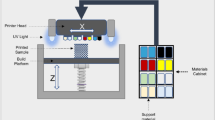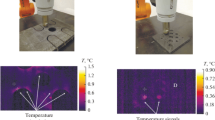Abstract
3D printed parts made from Polylactic acid (PLA) have a brittle nature when subjected to out-of-plane loading, e.g., impact. In this paper, we report the use of a pendulum impact test apparatus along with a high-speed camera and an Infrared (IR) thermography system to investigate impact damage characteristics of PLA 3D printed plates. The effects of impact energy levels, impact locations, and changes in layer thickness were examined for a clamped plate with a raster angle of 0° and a nominal thickness of 2.52 mm. The upper impact energy level (3 J) showed higher absorbed energy percentage than the lower impact energy level (1 J) for two impact locations, namely, central and off-center. For the 3 J impact energy, the maximum absorbed energy percentage for central loading was observed for specimens with 0.16 mm in layer thickness, while this occurred at 0.14 mm layer thickness for the off-center impact. For almost all layer thicknesses, the off-center loading resulted in a higher absorbed energy percentage compared with the central impact.











Similar content being viewed by others
References
Salem A, Singh M, Halbig MC (2015) 3-D printing and characterization of polymer composites with different reinforcements. Advanced processing and manufacturing technologies for nanostructured and multifunctional materials II. Ceram Eng Sci Proc 36(6):115
Ning F, Cong W, Hu Y, Wang H (2016) Additive manufacturing of carbon fiber-reinforced plastic composites using fused deposition modeling: effects of process parameters on tensile properties. J Compos Mater 51(4):451–462
Vidakis N, Vairis A, Petousis M, Savvakis K (2016) Fused deposition modelling parts tensile strength characterisation. Acad J Manuf Eng 14(2)
Garg A, Bhattacharya A (2017) An insight to the failure of FDM parts under tensile loading: finite element analysis and experimental study. Int J Mech Sci 120:225–236
Sood AK, Ohdar RK, Mahapatra SS (2010) Parametric appraisal of mechanical property of fused deposition modelling processed parts. Mater Des 31(1):287–295
Riddick JC, Haile MA, Wahlde RV, Cole DP, Bamiduro O, Johnson TE (2016) Fractographic analysis of tensile failure of acrylonitrile-butadiene-styrene fabricated by fused deposition modeling. Addit Manuf 11:49–59
Carneiro OS, Silva AF, Gomes R (2015) Fused deposition modeling with polypropylene. Mater Des 83:768–776
Ziemian S, Okwara M, Ziemian CW (2015) Tensile and fatigue behavior of layered acrylonitrile butadiene styrene. Rapid Prototyp J 21(3):270–278
Dawoud M, Taha I, Ebeid SJ (2016) Mechanical behaviour of ABS: an experimental study using FDM and injection moulding techniques. J Manuf Process 21:39–45
Álvarez K, Lagos RF, Aizpun M (2016) Investigating the influence of infill percentage on the mechanical properties of fused deposition modelled ABS parts. Ingeniería e Investigación 36(3)
Popescu D, Zapciu A, Amza C, Baciu F, Marinescu R (2018) FDM process parameters influence over the mechanical properties of polymer specimens: a review. Polym Test 69:157–166
Fayazbakhsh K, Movahedi M, Kalman J (2018) The impact of defects on tensile properties of 3D printed parts manufactured by fused filament fabrication. Mater. Today Commun. 18. 140–148
Caminero MA, Chacón JM, Garcia-Moreno I, Rodriguez GP (2018) Impact damage resistance of 3D printed continuous fibre reinforced thermoplastic composites using fused deposition modelling. Compos Part B 148:93–103
Chacón JM, Caminero MA, García-Plaza E, Núñez PJ, Reverte JM, Becar JP (2019) Additive manufacturing of PLA-based composites using fused filament fabrication: effect of graphene nanoplatelet reinforcement on mechanical properties, dimensional accuracy and texture. Polymers 11:799
Tsouknidas A, Pantazopoulos M, Katsoulis I, Fasnakis D, Maropoulos S, Michailidis N (2016) Impact absorption capacity of 3D-printed components fabricated by fused deposition modelling. Mater Des 102:41–44
Roberson DA, Perez ART, Shemelya CM, Rivera A, MacDonald E, Wicker RB (2015) Comparison of stress concentrator fabrication for 3D printed polymeric izod impact test specimens. Addit Manuf 7:1–11
Bax B, Müssig J (2008) Impact and tensile properties of PLA/Cordenka and PLA/flax composites. Compos Sci Technol 68(7–8):1601–1607
Es-Said OS, Foyos J, Noorani R, Mel M, Marloth R, Pregger BA (2000) Effect of layer orientation on mechanical properties of rapid prototyped samples. Mater Manuf Process 15(1):107–122
Caminero MA, García-Moreno I, Rodríguez GP, Chacón JM (2019) Internal damage evaluation of composite structures using phased array ultrasonic technique: impact damage assessment in CFRP and 3D printed reinforced composites. Compos B Eng 165:131–142
Cantwell WJ, Morton J (1991) The impact resistance of composite materials – a review. Composites 22(5):347–362
Nassir NA, Guan ZW, Birch RS, Cantwell WJ (2018) Damage initiation in composite materials under off-centre impact loading. Polym Test 69:456–461
Sy BL, Fawaz Z, Bougherara H (2017) Low velocity impact assessment of Kevlar/flax- epoxy composite using IR thermography, in CANCOM 2017
Sy BL, Fawaz Z, Bougherara H (2018) Damage evolution in unidirectional and cross-ply flax/epoxy laminates subjected to low velocity impact loading. Compos A: Appl Sci Manuf 112:452–467
ISO/ASTM 52921 (2013) Standard Terminology for Additive Manufacturing—Coordinate Systems and Test Methodologies, p 1–13
MIL-HDBK-17F (2002) Composite material handbook, Polymer matrix composite guidelines, vol. 1
Funding
The financial support of this research work was provided by the Natural Sciences and Engineering Research Council of Canada (NSERC), RGPIN-2018-04144.
Author information
Authors and Affiliations
Corresponding author
Additional information
Publisher’s note
Springer Nature remains neutral with regard to jurisdictional claims in published maps and institutional affiliations.
Rights and permissions
About this article
Cite this article
Desu, H.P.P., Rossi, A., Mankoo, G.K. et al. Experimental characterization of 3D printed thermoplastic plates subjected to low velocity impact. Int J Adv Manuf Technol 107, 1659–1669 (2020). https://doi.org/10.1007/s00170-020-05120-4
Received:
Accepted:
Published:
Issue Date:
DOI: https://doi.org/10.1007/s00170-020-05120-4




